Summary of Stéphane Mallarmé
Stéphane Mallarmé is considered one of the greatest French poets of the later nineteenth century. He is most closely associated with the loosely defined Symbolist movement in literature and art, which centered on the expression of emotions and sensations rather than on reproducing observed reality. Although he led a fairly low-profile, middle-class life (unlike some of his more famous, bohemian colleagues including Charles Baudelaire and Arthur Rimbaud), his innovative and challenging use of language proved highly influential for subsequent writers, artists, musicians, and philosophers. He was also a champion of many of the avant-garde artists of the time, including the Impressionists and Post-Impressionists. Mallarmé's Tuesday evening gatherings, which he held at his Parisian home from 1877 until his premature death in 1898, became a meeting place for many of the leading figures in European arts and culture of the time.
Accomplishments
- Mallarmé sought to use language to capture ideas and sensations that were not fully expressed in words, combining words in unexpected ways that were often difficult to interpret. As he wrote to a friend, he wanted to capture "not the thing, but the effect it produces... all the words should fade away before the sensation." Even the blank space of the page was significant, as demonstrated particularly by his poem "Un coup de dés jamais n'abolira le hasard," (A Throw of the Dice Will Never Abolish Chance), which is typeset with just a few words spread across otherwise empty pages.
- Mallarmé was one of the first - along with novelist and critic Edmond Duranty - to write an extended defense of the emerging Impressionists, penning an 1876 article on their work. His essay suggests that the Impressionist artists' goals, to record the visual effects of a subject or scene as an observer perceives them, rather than an objective description, were similar to his own in poetry.
- Like poet Charles Baudelaire and novelist Emile Zola, Mallarmé befriended many of the avant-garde artists of the time and used his writing to support and defend them against criticism. He also collaborated on numerous projects with them, from sitting for portraits to commissioning illustrations for his poems, although the challenge of providing a visual complement to his often enigmatic verses regularly proved difficult.
- The ideas of Symbolism brought together a variety of avant-garde practitioners of different art forms who shared Mallarmé's interest in expressing abstract concepts and emotions; as Alex Ross describes it, "the goal was to discover novel spheres of expression: the unspoken word, the unpainted image, the unheard sound." Examples include composer Claude Debussy, whose "Prelude to the Afternoon of a Faun" was inspired by Mallarmé's poem, and the disembodied dancing of Loie Fuller - with whom the poet was fascinated - which was enhanced by flowing robes and colored lights.
The Life of Stéphane Mallarmé
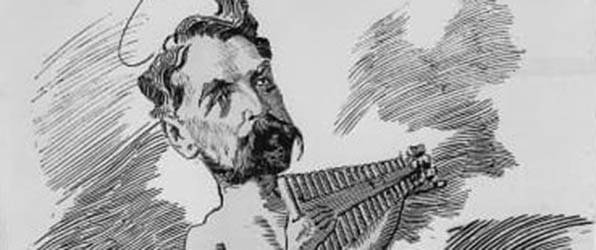
Mallarmé's writing was usually conventional in its form but radical in its aim to take apart language and find meaning beyond words; "I know of no other bomb than a book," he once wrote. As an avant-garde artist himself, he befriended and championed many other modern artists.
Stéphane Mallarmé and Important Artists and Artworks
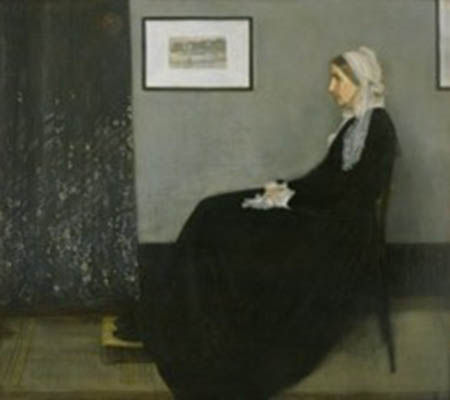
Arrangement in Grey and Black No.1 (1871)
Arguably James McNeill Whistler's most famous painting - often referred to as Whistler's Mother - this work shows Anna McNeill Whistler seated in left profile in the artist's studio in London. Wearing a black dress and a white lace cap, she stares steadily forward, her hands folded in her lap. The background is as austere as her dress, featuring a long black curtain or textile of Japanese design and one of Whistler's own etchings of the Thames River, Black Lion Wharf. The simplicity and shallow space of the composition, its emphasis on broad shapes, and the painting's original designation as an "arrangement" all highlight the artist's desire to focus on the abstract qualities of form and color rather than on narrative content in his work.
These goals surely appealed to Mallarmé, who similarly wished to capture immaterial effects in his poetry. The two men met in 1888 at Claude Monet's studio where, according to author Gordon Millan, "Mallarmé was greatly impressed by Whistler, whose ironic sense of humor and independent spirit struck a particular chord." Their professional relationship was initiated when the poet translated the artist's "Ten O'Clock Lecture" (in which he argued for the aesthetic value of art for its own sake) into French. And in 1891, when Whistler sought to sell the Arrangement in Grey and Black, Mallarmé was instrumental in securing its purchase by the French government, initially for the Luxembourg Museum to be transferred later to the Louvre. The painting also earned Whistler the honor of being named a chevalier of the Légion d'honneur, which Mallarmé himself presented to him in 1892. Whistler, for his part, made a lithograph portrait of Mallarmé which was published as the frontispiece to an anthology of his poems in 1893.
Oil on canvas - Musée d'Orsay, Paris
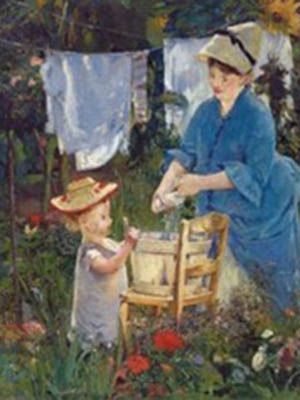
Le Linge (Laundry) (1875)
A woman accompanied by her child stands in the somewhat overgrown yard of a Parisian house, hanging out laundry to dry. The child is intent on her mother's chore, fascinating by the water pouring into the bucket, while the mother is equally absorbed in tenderly observing her child. Manet's painting was rejected for exhibition in the Paris Salon of 1876, so the artist determined to display it in his own studio, which he opened to the public for two weeks in April in an act of protest against the art establishment. The rejection also inspired Mallarmé to write an article for the September issue of the London periodical The Art Monthly Review titled "The Impressionists and Édouard Manet" in which he defined and defended Impressionism and its artists, although Manet never participated in the exhibitions that defined the group. It was, according to author Margaret Werth, "...arguably the most sophisticated reading of Impressionism in the 1870s."
In this now famous article, Mallarmé described the vibrant colors and play of light in this painting as a "fusion or ... struggle ever continued between surface and space, between color and air." He went on to suggest that contemporary artists' true medium was air, as they painted subjects outdoors that "palpitate[d] with movement, light, and life." As Werth notes, Mallarmé's emphasis on the atmospheric space around objects in Manet's work parallels his own search for meanings and sensations that eluded expression in the words of his poetic writing. This essay identified some of the radical goals of Manet and his Impressionist colleagues and helped solidify the relationship between the artist and the poet.
Barnes Foundation, Philadelphia

Stéphane Mallarmé (1876)
This painting captures a sense of Mallarmé's relationship with Manet, as well as of the poet's creative process. It depicts him comfortably seated in the artist's studio, which he visited "every day for ten years," he later claimed, to spend the afternoon in conversation with the artist and his colleagues. It was painted in the same year that Mallarmé wrote his article "The Impressionists and Édouard Manet," and that Manet supplied illustrations for Mallarmé's "Afternoon of a Faun." Mallarmé proudly displayed this portrait in his own apartment, where visitors to his Tuesday evening salons could admire it, and kept it throughout his life, passing it down to his daughter who then gave it to the Louvre.
The artist's body is entirely relaxed, leaning back into the sofa, while his mind seems actively engaged in reverie. The smoke rising from his cigar - which rarely left his hand - suggests his drifting state of mind, but it also gives visible form to the movement and air that Mallarmé proposed in his article as the true subject of the plein-air painters of contemporary life. In a poem published some twenty years later, he directly linked cigar smoke and creative expression, writing "all the soul is summarized / when we exhale it slowly / in several rings of smoke / abolished by other rings." Even the gesture of resting his hand on several sheets of paper suggests the creative act, as if his thoughts were being directly transmitted to the page. Although the portrait is small, Manet has effectively created both a physical and spiritual likeness of his friend.
Oil on canvas - Musée d'Orsay, Paris
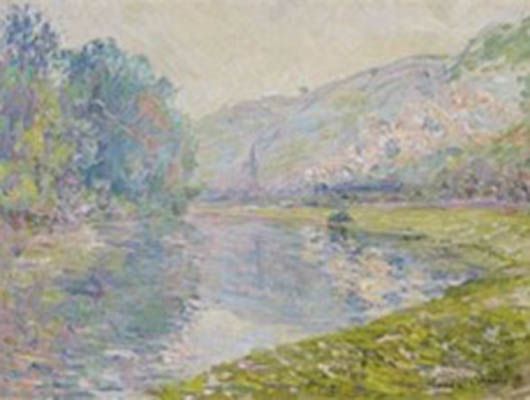
The Train at Jeufosse (1884)
Claude Monet painted the Seine throughout his life - as Mallarmé noted in his 1876 article "The Impressionists and Édouard Manet," "...Monet loves water, and it is his especial gift to portray its mobility and transparency, be it sea or river, grey and monotonous, or colored by the sky." In 1883 Monet moved to the village of Giverny, which he chose in part for its proximity to the river, and outfitted a boat to serve as a floating studio. The following year he found the subject of this painting when he took his boat a short distance up the river to the village of Jeufosse, executing about ten canvases in this location. In this work, the atmosphere is suffused with light which glimmers on the surface of the water, dissolves the background in a haze, and tinges with pink the thick puffs of smoke emanating from a train cutting through the landscape.
Monet was a frequent guest at Mallarmé's Tuesday evening salons. It was most likely at one of these events that Mallarmé formed the idea in 1887 to create a volume of poetry he wanted to title Le Tiroir de laque (The Lacquer Drawer) which would include original illustrations by many artists in his circle. The project was never realized, however, as most of the artists struggled to complete their tasks. Monet was to illustrate a prose-poem that described a train trip, but since he had little experience as a printmaker, he felt unable to create the required lithograph. Instead, several years later in summer 1890, when Mallarmé along with Morisot and her husband Eugène Manet were visiting Monet in Giverny, the artist invited the poet to choose a painting as a token of their continuing friendship. Perhaps because of the subject matter, he chose The Train at Jeufosse, and as he wrote to the artist, he was so pleased with it that he "slept little the first night, looking at it." Like the portrait of the poet by Manet, this painting remained with Mallarmé and his descendants until at least the 1930s.
Oil on canvas - Private Collection
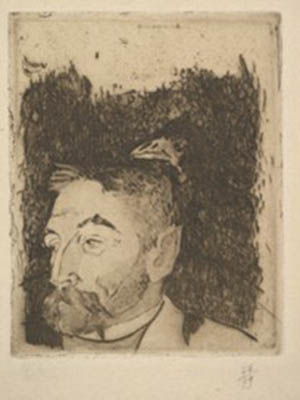
Portrait of Stéphane Mallarmé (1891)
In this enigmatic portrait, Gauguin has placed Mallarmé's head unusually low in the composition, filling the remaining background with dark, heavily worked marks and tones and leaving the empty space of the sheet above. A raven's head partially emerges from the darkness, hovering over the poet. The two men met in late 1890 or early 1891 through a mutual friend, Symbolist poet Charles Morice, who brought Gauguin to one of Mallarmé's Tuesday evening salons. To raise money to travel to Tahiti, Gauguin was planning a sale of his paintings in February 1891, and hoped that Mallarmé would write an article supporting his work and the sale. Although Mallarmé declined the request, he attended the event, which successfully raised several thousand francs. By April Gauguin had left Paris, but on his subsequent return visits he always made an effort to attend Mallarmé's mardis, and the poet continued to support his work.
Gauguin's portrait alludes to the artistic and creative network to which he and Mallarmé belonged. The raven clearly points to what the writer considered one of his greatest achievements, a translation of Edgar Allan Poe's The Raven. Its form also echoes the lithograph Édouard Manet made in 1875 for the poster and outer cover of the illustrated volume of Mallarmé's translation, which similarly features just the bird's head in profile. Gauguin's portrait is also one of his only etchings, as he usually preferred the techniques of woodcut or monotype. As writers Jessica Keuskamp and Heather Lemonedes have suggested, the artist may have wished to portray the refined, cerebral poet in a more precise medium than the rougher, more forceful techniques he usually used.
Etching - The Metropolitan Museum of Art, New York
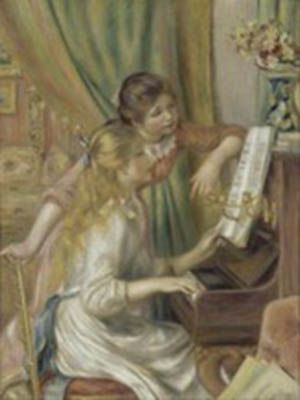
Young Girls at the Piano (1892)
This work is characteristic of Renoir's later style, as the forms of the figures and the background are clearly defined and the brushwork soft and evenly blended. Renoir had treated the subject of young women playing music several times earlier, as he did in the 1888 portrait of the daughters of Symbolist poet Catulle Mendès. Here, rather than depicting identifiable individuals, he has rendered a more generalized image of youthful grace and beauty, and comfortable bourgeois leisure. The subject also alludes to traditional images of women playing music by artists such as Jean-Baptiste-Siméon Chardin, a historical precedent that was perhaps appropriate for an official commission.
This is one of five versions Renoir painted of this composition, which he produced at the request of the Fine Arts administration; Mallarmé, along with the writer Roger Marx, had played a significant role in prompting the informal commission from the French State. Knowing that the painting would enter the Luxembourg Museum, the national collection of living artists' work, Renoir labored longer over the project than nearly any of his other paintings. The artist, who twenty years earlier had joined his Impressionist colleagues in rebelling against the state-controlled art system, saw this painting's acceptance as a validation and confirmation of his artistic significance. In an act of appreciation Renoir painted Mallarmé's portrait, just one of many artists to thank the poet in this way.
Oil on canvas - Musée d'Orsay, Paris
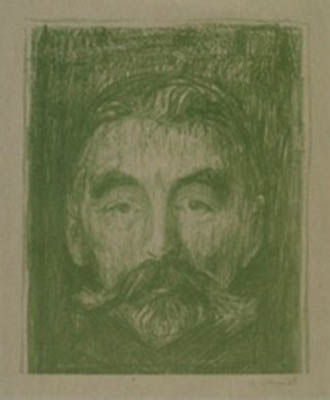
Stéphane Mallarmé (1897)
Like so many artists and writers, Munch was drawn to Mallarmé's well-known Tuesday evening salons, and first met the poet during a trip to Paris in 1896-97. Munch's interest in expressing emotion and sensations in his work aligned with the ideas of the Symbolist movement with which Mallarmé was affiliated, although Munch's images were often more intensely expressive than those of his French colleagues. He was also a skilled printmaker, making innovative use of varied techniques, media, and color. This portrait presents the poet's disembodied head against a dark, atmospheric background, while the artist's choice of a dark greenish ink lends it a mystical, otherworldly quality.
The print may have been intended to illustrate a volume of Mallarmé's poems, although like a number of these projects, the book seems never to have been realized. Nonetheless, Mallarmé was pleased with the work, describing it as "a gripping portrait, which gives me an intimate sense of myself'."
Transfer lithograph with crayon and scraping in green on cream Japanese paper - The Art Institute of Chicago
Biography of Stéphane Mallarmé
Childhood and Education
Stéphane Mallarmé, christened Étienne, was the first child born into a prosperous middle class family. His father, Numa, who worked in the government's Registry office, and mother, Elisabeth-Félicie Desmolins, also had a daughter, born two years later. At the age of five Mallarmé lost his mother to what was believed to be a rheumatic illness, an affliction that would plague many of his family members.
After his father remarried a little more than a year later and the first of three half siblings was born, the eight-year-old Mallarmé was sent away to a boarding school while his six-year-old sister Maria went to stay with his maternal grandparents. Likely due to the bitterness he felt from his perceived rejection by his father, Mallarmé proved to be a poor student who acted out in class. He was also deeply affected when his beloved sister died in August 1857 of a rheumatic attack.
Early Training
Mallarmé first became interested in literature in February 1859 when as a baccalaureate student he suffered his first rheumatic attack, which rendered him seriously ill for several weeks. While recovering he turned to poetry for comfort, a pursuit that displeased his father and grandparents, who hoped it would prove to be simply a passing hobby. Far from tiring of it, however, he began to write his own poems in this period.
Upon graduating, Mallarmé tried to appease his family by beginning an apprenticeship at the Registry office in Sens. Although he hated the work, it was during this period that he made friends with Emmanuel des Essarts, a poet who taught at his former school. With his new friend's encouragement Mallarmé submitted poems to journals and began writing theater reviews. It was also during this time that he met Maria Gerhard, a German governess seven years his senior who was working for a family in Sens and with whom he began a relationship, a fact he kept secret from his family as he knew they would object.
After two years, Mallarmé decided to leave the Registry office and become a teacher. He set out in November 1862 for a year of study in London so that he could become fluent in English and then teach the subject upon returning to France. Maria joined him for a time, and in August 1863 the couple married, an event dampened by the death of Mallarmé's father only a few months earlier.
In September, Mallarmé passed his exam to be a teacher and was assigned a post teaching English in the provincial town of Tournon. It was there that the couple's first child, Geneviève, was born in November 1864.
Mature Period
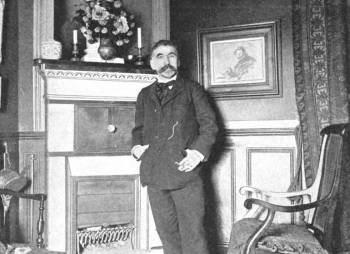
By his own account as well as that of observers, Mallarmé proved to be a poor teacher, although he continued in the profession for some thirty years. At the same time, he began to have some success in publishing his poems; eleven of his early works appeared in the poetry collection Le Parnasse contemporain in 1866, and he continued to publish steadily in the following years and earn a growing renown. The school in Tournon was not pleased with his extracurricular activity, however, and dismissed him, prompting a transfer in November 1866 to a new school in Besançon and the following year to another school in Avignon. Both he and his wife struggled with illness and, according to Gordon Millan, "during this era, he experienced moments of dark despair and great personal anguish." The year 1871 was significant for several reasons, however. Shortly after the civil unrest caused by the Paris Commune, the couple's son, Anatole, was born, in July 1871, and in the fall of that year Mallarmé was appointed to a school in Paris.
While he still did not like teaching, he was now at least able to do so in a city he loved. As Roger Pearson explains, "now aged 28 and more or less securely settled in Paris, Mallarmé was able to revel fully in the company of all the poets he had met over recent years." His first important friendships were with poet Paul Verlaine and art critic Philippe Burty, who was well connected in the Paris art world.
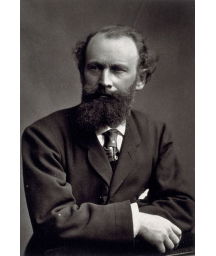
Of all his new artist friends, it was arguably Édouard Manet who had the most profound impact on the direction of his career. Mallarmé first met Manet, ten years his senior, at the salon of mutual friend in 1873. Since the poet lived and worked in the same neighborhood where Manet's studio was located, he began to visit the artist regularly in the afternoons after he finished teaching - "I saw my dear Manet every day for ten years," Mallarmé later recalled. The two shared an interest in challenging tradition to develop new forms of expression, and through Manet, Mallarmé met many members of the emerging avant-garde including Edgar Degas, Claude Monet, Berthe Morisot, Pierre-Auguste Renoir, photographer Nadar (Gaspard-Félix Tournachon), and writer Émile Zola.
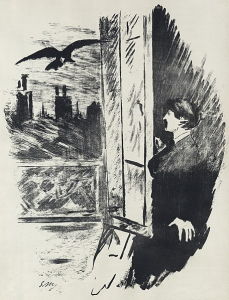
In addition to their deep friendship, Manet and Mallarmé helped each other professionally. When the jury for the annual Paris Salon rejected two of Manet's paintings in 1874, it was Mallarmé who defended him in an article published in the journal La Renaissance littéraire et artistique in April 1874. Manet, for his part, contributed the illustrations for Mallarmé's translation of his beloved Edgar Allan Poe poem "The Raven" in 1875 and for a new edition of his 1865 poem "Afternoon of a Faun" the following year. He also painted a small but evocative portrait of the poet in 1876 (Musée d'Orsay). At about the same time, Mallarmé published "The Impressionists and Édouard Manet" in the September issue of the London journal The Art Monthly Review, one of the first overviews of the new movement and Manet's significance within it. As scholar Margaret Werth explores, Mallarmé's identification of motion and air as the Impressionists' primary subject matter parallels the poet's own efforts to convey meanings that are not fully captured by words, his desire to render "not the thing, but the effect it produces."
Manet's influence also helped shape another of Mallarmé's life decisions as, according to author Thirza Vallois, "it was Manet who urged Mallarmé to seek a country retreat, 'to forget everything'." On a vacation with his family he discovered Valvins and fell in love with the quaint village and its location near the Forest of Fontainebleau; he believed such peaceful surroundings would help nurture his writing. He and his family would spend the majority of their summers there for the rest of his life.
Despite his increasing professional successes, Mallarmé continued to struggle with his limited teaching salary and little income from his writing. Moreover, his son Anatole developed rheumatic illness and died in October 1879 at the age of eight. Both parents were devastated by their son's death, to which Mallarmé responded by trying to capture his son's memory in a poem, "For Anatole's Tomb," which he never finished.
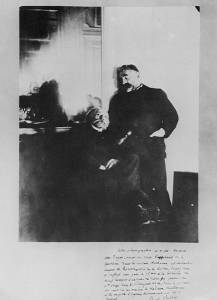
Friends and society slowly drew Mallarmé out of his grief and in 1881 he resumed a practice he had begun in 1877, hosting Tuesday (mardi, in French) evening salons in his apartment. The guests included many in the Parisian art and literary world. As Pearson explains, "Mallarmé's mardi became more famous than any of its weekday alternatives, and endured for the rest of his life (when he was not at Valvins) as the one Parisian gathering to which any ambitious young writer or artist - or cultural tourist - sought admission."
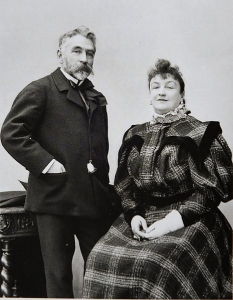
Mallarmé was again deeply affected by the death of his friend Manet on April 30, 1883. The event seemed to increase his intimacy with Méry Laurent, an actress and friend of Manet's whom he had first met years before and who had worked as Manet's model for a time. The relationship hurt his wife and daughter, but they tolerated her presence at his Tuesday salons, and even her being the source of inspiration for some of his poems. While the affair eventually ended, the pair remained good friends for the rest of Mallarmé's life.
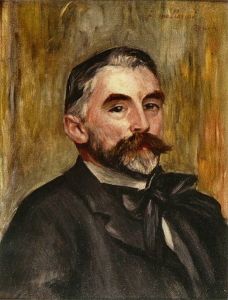
For decades Mallarmé received only limited public recognition beyond his circle of professional friends in large part because the general public found his work difficult to understand. Two key events took place in 1884 that brought him much wider renown. Fellow poet Paul Verlaine featured him as one of three writers in his book of essays Les poètes maudits (Cursed Poets), and in novelist and critic J.K. Huysmans's À Rebours (Against the Grain), the main character, aesthete Jean des Esseintes, cites Mallarmé as one of his favorite poets. He continued to maintain close friendships with numerous artists, particularly Berthe Morisot, at whose home he was a regular guest for dinners that frequently included Degas, Monet, and Renoir. It was through Monet that Mallarmé also met American artist James McNeill Whistler, with whom he developed a beneficial friendship and professional relationship. Although Mallarmé attempted further collaborations with these artists, the projects often proved difficult to complete. His 1887 proposal to produce a collection of poems titled Le Tiroir de laque (The Lacquer Drawer) with illustrations by several of the Impressionists, was never realized, and the efforts of Odilon Redon to provide illustrations for his 1897 poem "Un coup de dés jamais n'abolira le hasard" (A Throw of the Dice Will Never Abolish Chance) were similarly unsuccessful.
Late Period
While poetry was his life's passion, Mallarmé always had to rely on teaching to support himself and his family. His health continued to decline, however, and he felt he could no longer continue, so in November 1893, at the age of fifty-one, he was granted approval to retire from teaching for medical reasons. He began his retirement years giving a series of lectures at Oxford and Cambridge Universities. He also continued his Tuesday evening salon gatherings when he was in Paris. This period also saw the first performance of composer Claude Debussy's "Prélude à l'après-midi d'un faune" (inspired by Mallarmé's poem) in 1894, the publication of a poem honoring artist Pierre Puvis de Chavannes on his seventieth birthday in 1895, and, after Berthe Morisot's death in March 1895, the organization of an exhibition of her work the following year, for which Mallarmé wrote the catalogue introduction. He and Renoir then became the joint guardians of Julie Manet, the daughter of Morisot and Eugène Manet, Edouard's brother.
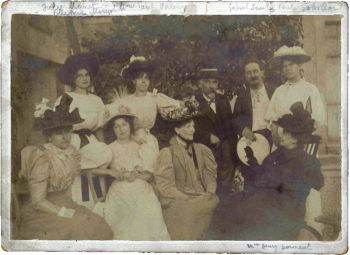
In the last years of his life Mallarmé found the most comfort in his home in Valvins. In addition to spending time with his family, he was often surrounded by friends including Redon, who lived nearby, Rodin, and Whistler. When not entertaining friends, Mallarmé spent much of his time working on his epic work "Hérodiade" a project he had begun decades before in October 1864 but never completed. Much to his dismay he found he was growing too tired even to write. Of this feeling he noted, "it is all rather a waste of time living behind closed shutters. A lethargy settles within me which can be felt materially in the pen itself."
In early September 1898 Mallarmé developed a sore throat and was diagnosed with tonsillitis. Despite the relatively benign ailment, a few days later while in the middle of a conversation with the doctor who had come to check in on him, he fell into a violent coughing fit, asphyxiated, and died. He was only fifty-six years old.
The Legacy of Stéphane Mallarmé
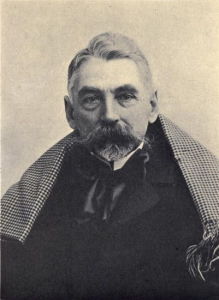
Mallarmé cultivated a wide range of creative associates and friends, often resulting in mutually beneficial relationships, most notably with Édouard Manet and the Impressionist artists. His article "The Impressionists and Édouard Manet" helped to define and legitimize the emerging group, and in later years he continued to support many artists through his writing and his efforts to secure their places in the art historical establishment. In return, they produced portraits, paintings, and prints for him that he cherished throughout his life.
As a writer, he earned praise from contemporaries including poet Paul Verlaine and critic J. K Huysmans and inspired younger writers including André Gide and Paul Valéry, who left the most extensive record of the experience of Mallarmé's Tuesday salons. His work also inspired a wide range of later figures in the arts, some of whom drew directly from his writing as source material while others continued his exploration of the way language functions for their own work in the fields of philosophy and literary theory. In this sense, as writers Alex Ross and Nasrullah Mambrol note, his exploration of chance informed figures including avant-garde composer John Cage, while his linguistic experiments inspired writers including Jean-Paul Sartre, Jacques Lacan, Roland Barthes, and Michel Foucault.
Influences and Connections

-
![Charles Baudelaire]() Charles Baudelaire
Charles Baudelaire ![Theophile Gautier]() Theophile Gautier
Theophile Gautier![Edgar Allan Poe]() Edgar Allan Poe
Edgar Allan Poe- Théodore de Banville
- J.K. Huysmans
-
![Pierre Puvis de Chavannes]() Pierre Puvis de Chavannes
Pierre Puvis de Chavannes -
![Edgar Degas]() Edgar Degas
Edgar Degas -
![Paul Gauguin]() Paul Gauguin
Paul Gauguin -
![Édouard Manet]() Édouard Manet
Édouard Manet - Félix Bracquemond
-
![Roland Barthes]() Roland Barthes
Roland Barthes ![André Gide]() André Gide
André Gide- Claude Debussy
- Julia Kristeva
- Jacques Lacan
Useful Resources on Stéphane Mallarmé
- Les Mardis: Stéphane Mallarmé and the Artists of His CircleBy Marilyn Stokstad and Brett Waller
- Manet, Monet, and the Gare Saint LazareBy Juliet Wilson-Bareau
- A Throw of the Dice: The Life of Stéphane MallarméOur PickBy Gordon Millan
- Stéphane MallarméOur PickBy Roger Pearson
 Ask The Art Story AI
Ask The Art Story AI














